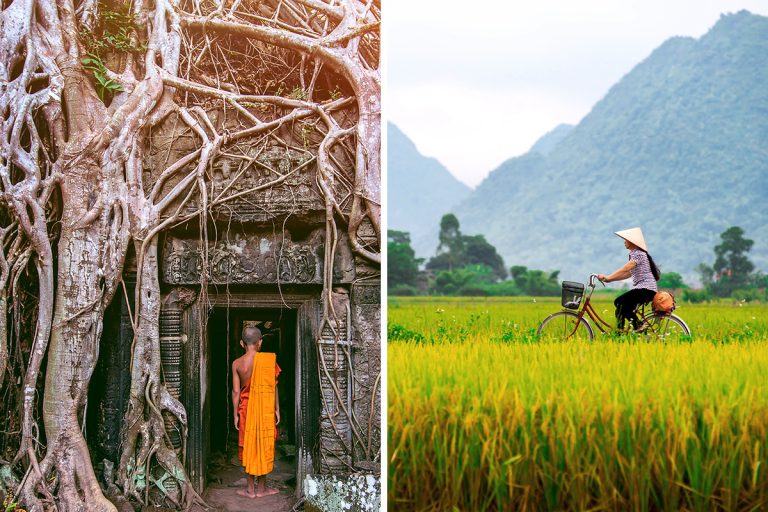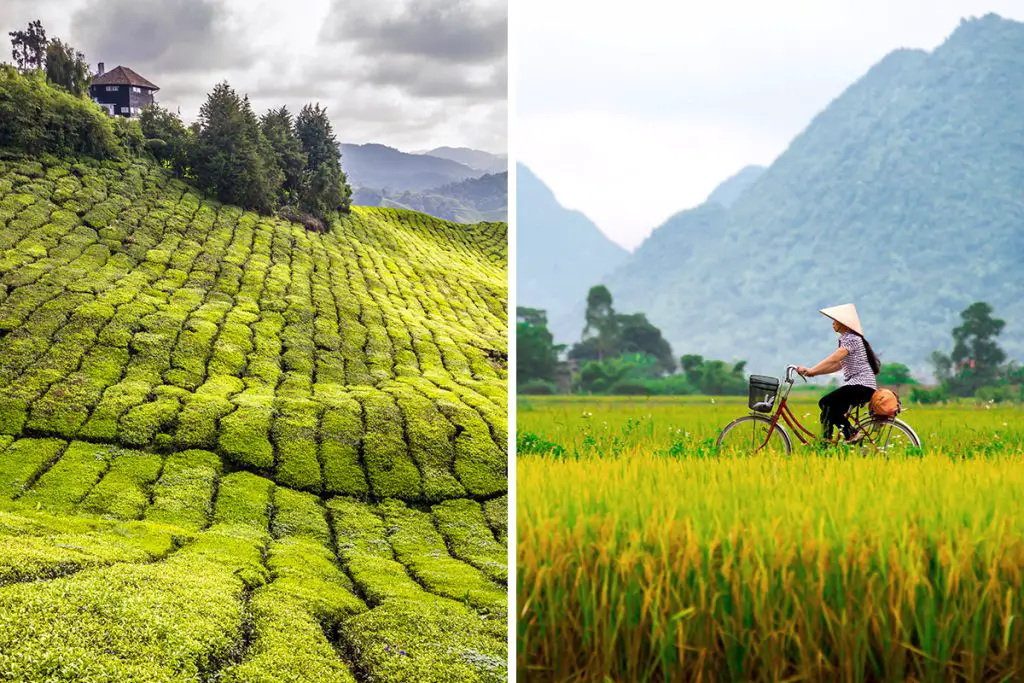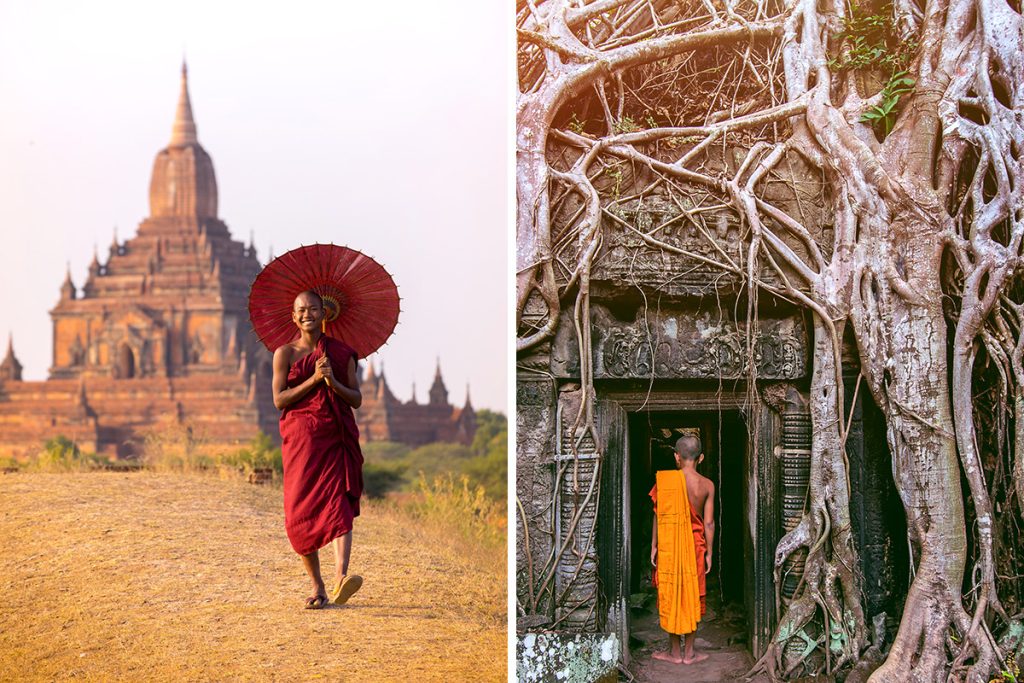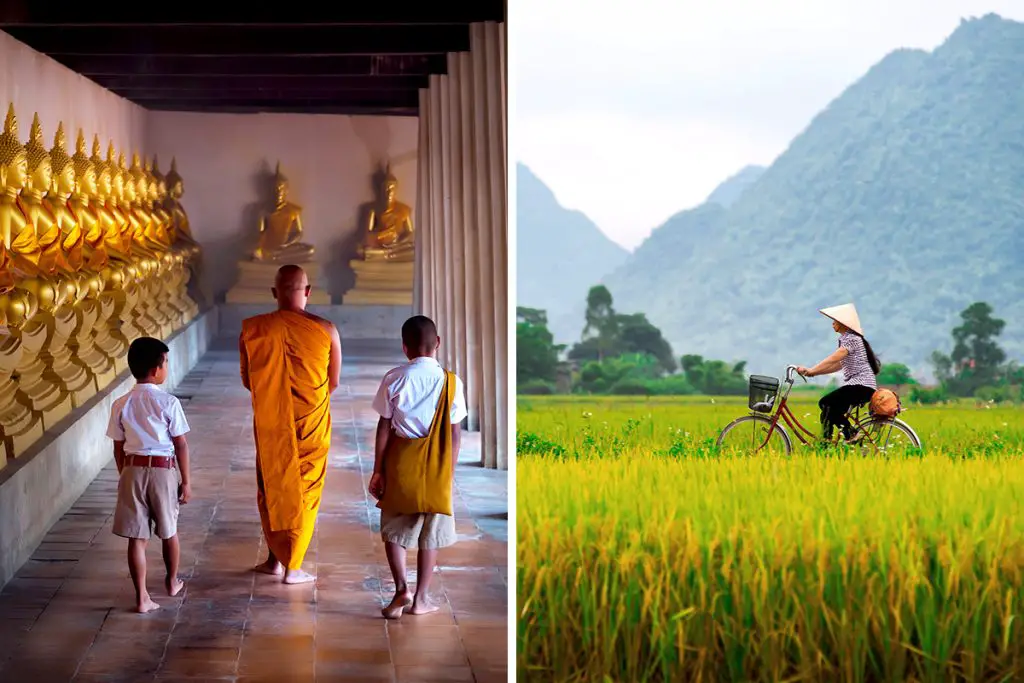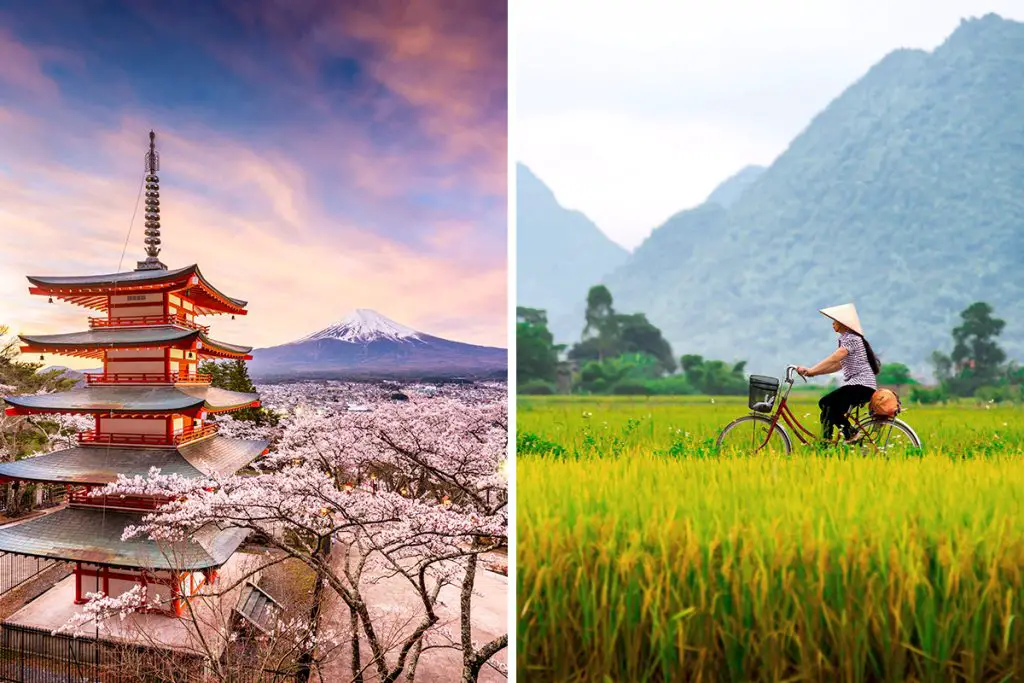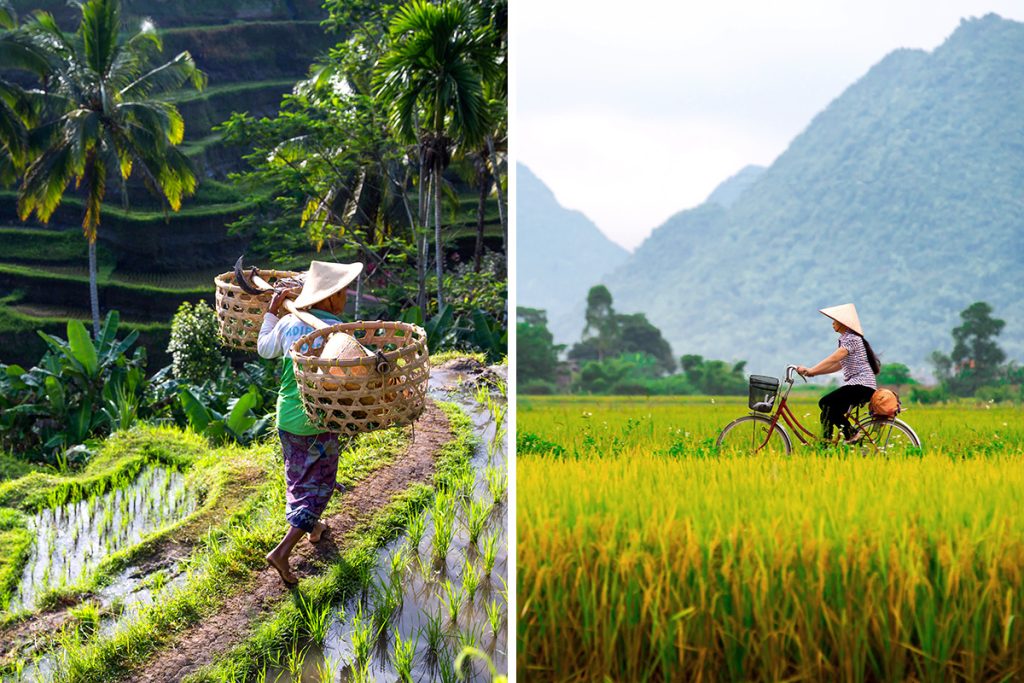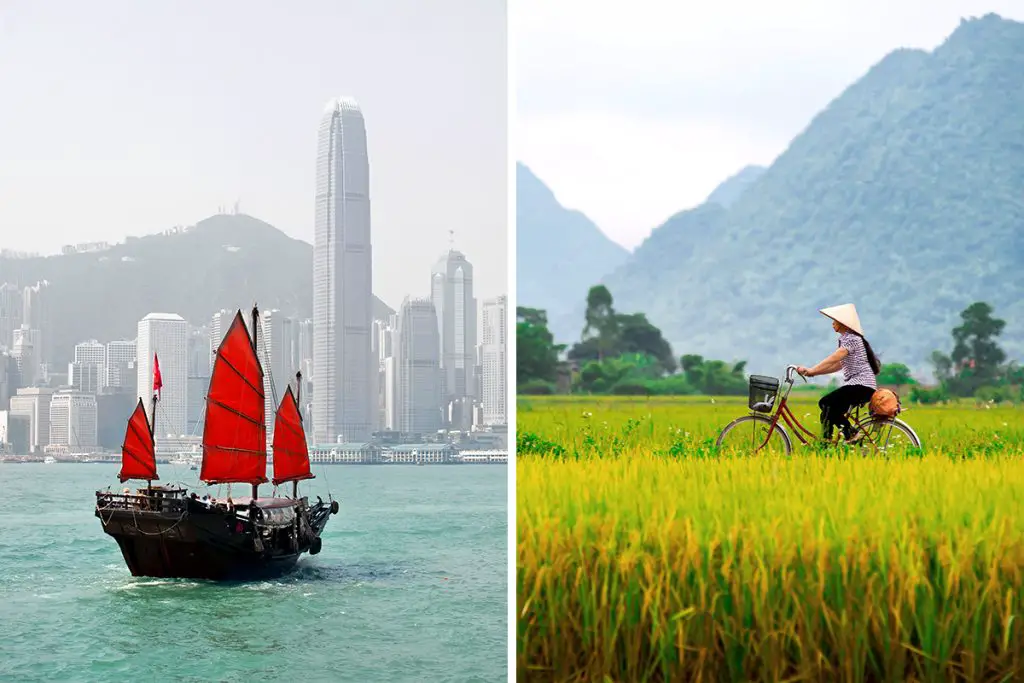These two Southeast Asian neighbors have much to offer, and this comprehensive comparison will help you make an informed choice. Continue reading to discover the highlights and hidden gems of Cambodia and Vietnam, and find out which country best suits your travel preferences. So, are you ready to uncover the secrets of these captivating destinations?
History & Culture
Diving into the history and culture of Cambodia and Vietnam offers fascinating insights into their pasts. Both countries have experienced tumultuous histories and boast distinctive cultural identities.
In Cambodia, the ancient Khmer Empire left a lasting legacy. The temples of Angkor, a UNESCO World Heritage site, are a testament to this civilization’s architectural prowess. Cambodia’s traditional dance, called Apsara, and its unique musical instruments showcase the nation’s rich cultural heritage.
On the other hand, Vietnam’s history has been shaped by various influences, including Chinese, French, and American occupations. This diverse past is reflected in Vietnam’s architecture, such as the mix of French colonial buildings and traditional Vietnamese structures.
Vietnamese culture is deeply rooted in Confucianism, with a strong emphasis on family values and respect for elders.
Cambodia’s modern art scene is blossoming, with young artists finding inspiration in their nation’s history and traditions. In contrast, Vietnam’s contemporary art scene is vibrant and rapidly evolving, as artists explore various styles and techniques.
Both countries celebrate numerous festivals throughout the year. Cambodia’s most famous event is the Water Festival, while Vietnam’s Lunar New Year, known as Tết, is an important family occasion.
In summary, Cambodia and Vietnam offer unique historical and cultural experiences. Cambodia’s ancient past and rich artistic heritage contrast with Vietnam’s diverse influences and dynamic art scene.
Attractions & Activities
When it comes to attractions and activities, both Cambodia and Vietnam have plenty to offer. This section will provide a glimpse into the highlights of each country.
In Cambodia, exploring the iconic Angkor Wat complex is a must. Other worthwhile sites include the Royal Palace in Phnom Penh and the charming riverside town of Battambang, where you can ride the famous bamboo train.
Vietnam, on the other hand, offers a wide range of attractions, such as the bustling city of Ho Chi Minh City and its historical sites like the War Remnants Museum. The ancient town of Hoi An, a UNESCO World Heritage site, is perfect for strolling through its well-preserved streets.
Outdoor enthusiasts will enjoy Cambodia’s lush landscapes, with opportunities for trekking in the Cardamom Mountains and wildlife spotting in Mondulkiri Province.
Similarly, Vietnam’s diverse natural beauty offers ample opportunities for trekking in Sapa, exploring the world’s largest cave in Phong Nha-Ke Bang National Park, and cruising through the breathtaking Halong Bay.
Both countries provide unique cultural experiences. In Cambodia, you can witness traditional Apsara dance performances or learn about silk weaving in local villages. In Vietnam, you can attend traditional water puppet shows or participate in cooking classes to learn about Vietnamese cuisine.
To summarize, Cambodia and Vietnam offer a wide range of attractions and activities. From ancient temples and bustling cities to stunning natural landscapes and immersive cultural experiences, both countries promise unforgettable adventures.
Beaches
When planning a beach vacation, choosing between Cambodia and Vietnam can be tough. Both countries boast stunning coastlines with picturesque beaches, perfect for soaking up the sun and enjoying the warm waters.
Cambodia’s coastline stretches over 275 miles (443 km) along the Gulf of Thailand. The most popular beach destination is Sihanoukville, offering white-sand beaches like Otres Beach and Serendipity Beach. For a more remote experience, visit the untouched Koh Rong and Koh Rong Sanloem islands, boasting pristine beaches and crystal-clear waters.
In contrast, Vietnam’s coastline spans over 2,025 miles (3,260 km), providing a diverse range of beach options. Nha Trang is a bustling beach city, where you’ll find long stretches of golden sand and clear waters. For a more laid-back atmosphere, head to the charming town of Hoi An, with its nearby An Bang and Cua Dai beaches.
Cambodia’s beaches are ideal for relaxation and water activities, such as snorkeling and scuba diving. The islands of Koh Rong and Koh Rong Sanloem offer vibrant coral reefs teeming with marine life.
Vietnam’s beaches also provide excellent water sports opportunities, including windsurfing, kite surfing, and sailing. The country’s picturesque bays, such as Halong Bay, offer unique scenery and a range of activities like kayaking and rock climbing.
In summary, both Cambodia and Vietnam offer fantastic beach experiences. Whether you prefer the secluded islands of Cambodia or the diverse coastline of Vietnam, you’ll find a beach destination that suits your taste.
Eating, Drinking & Nightlife
The culinary scenes in Cambodia and Vietnam are both diverse and delicious, offering unique flavors and experiences for food lovers. From street food to fine dining, both countries promise unforgettable gastronomic adventures.
In Cambodia, you’ll discover dishes influenced by Thai, Vietnamese, and French cuisines. Must-try dishes include fish amok, a creamy coconut curry, and kuy teav, a flavorful noodle soup. The bustling markets in Phnom Penh and Siem Reap are perfect for sampling local street food.
Vietnamese cuisine, on the other hand, is known for its fresh ingredients and vibrant flavors. Pho, a fragrant noodle soup, and banh mi, a baguette sandwich, are just a few examples of the country’s delicious dishes. Hanoi and Ho Chi Minh City offer a wide range of eateries, from street vendors to upscale restaurants.
For drinking, Cambodia’s local beer, Angkor, is a refreshing option to enjoy after a day in the sun. Cambodia also has a growing craft beer scene, with microbreweries offering unique and flavorful brews.
In Vietnam, the local beer, Bia Hơi, is a popular choice, often served in lively street-side bars. The country is also known for its coffee culture, with its signature Vietnamese iced coffee enjoyed by locals and tourists alike.
When it comes to nightlife, Cambodia’s Siem Reap and Phnom Penh offer lively bars and clubs, with Pub Street being the go-to spot for a night out in Siem Reap. Vietnam’s nightlife varies from city to city, with Hanoi’s Old Quarter providing a more traditional experience and Ho Chi Minh City offering a vibrant club scene.
In conclusion, both Cambodia and Vietnam provide rich culinary experiences, diverse drinking options, and lively nightlife scenes. Whether you’re a food enthusiast or a party lover, you’ll find something to enjoy in both countries.
Shopping
Shopping is an exciting part of any vacation, and both Cambodia and Vietnam offer unique opportunities for you to find local treasures and souvenirs. Each country has its own distinctive products and markets that cater to a variety of tastes.
In Cambodia, you can explore traditional markets, such as Phnom Penh’s Central Market and Siem Reap’s Old Market. These bustling bazaars offer a range of items, including handicrafts, textiles, and silverware. The famous Cambodian silk and colorful krama scarves make perfect keepsakes.
Vietnam’s shopping scene is equally vibrant, with markets like Hanoi’s Dong Xuan Market and Ho Chi Minh City’s Ben Thanh Market. These bustling hubs offer a variety of products, such as intricate lacquerware, beautiful ceramics, and unique hand-embroidered items.
Beyond markets, Cambodia has a growing number of boutique shops and galleries, particularly in Siem Reap. These establishments showcase contemporary Cambodian art and design, offering unique and high-quality products.
In Vietnam, you’ll find a mix of traditional shops and modern shopping malls, especially in larger cities like Hanoi and Ho Chi Minh City. These retail spaces provide an array of local and international brands, as well as designer boutiques.
For bargain hunters, both countries offer the chance to practice your haggling skills. Negotiating prices is a common practice in the markets of Cambodia and Vietnam, and it can be a fun and rewarding experience.
In summary, Cambodia and Vietnam both provide diverse shopping experiences, from traditional markets to modern malls. Whether you’re searching for local handicrafts or designer goods, you’re sure to find something to suit your tastes in both countries.
Accommodation
Finding the right accommodation is essential when planning your trip to Cambodia or Vietnam. Both countries offer a variety of options, ranging from budget-friendly hostels to luxury hotels.
In Cambodia, you’ll find affordable guesthouses and hostels in popular tourist areas like Phnom Penh and Siem Reap. For a more luxurious stay, you can choose from boutique hotels or upscale resorts, often featuring traditional Khmer architecture and decor.
Vietnam’s accommodation options are equally diverse, with budget-friendly hostels and guesthouses available in major cities like Hanoi and Ho Chi Minh City. For those seeking a more indulgent experience, Vietnam offers a range of high-end hotels and resorts, some boasting stunning beachfront locations or breathtaking views.
Both countries have options for travelers seeking a more authentic experience. In Cambodia, you can choose to stay in a traditional wooden house, while Vietnam offers homestays in local villages, allowing you to immerse yourself in the local culture.
No matter your budget or preference, both Cambodia and Vietnam provide a variety of accommodation choices to suit your needs.
In conclusion, whether you’re looking for budget-friendly options or luxurious retreats, Cambodia and Vietnam cater to a wide range of accommodation preferences. The variety of choices ensures you’ll find the perfect place to rest and recharge during your trip.
Family-Friendliness & Children’s Activities
When planning a family vacation, it’s essential to consider the available activities and attractions for children. Both Cambodia and Vietnam offer unique experiences that cater to families, making your trip enjoyable for everyone.
In Cambodia, you can explore the ancient temples of Angkor Wat, where kids can marvel at the impressive architecture and learn about the country’s rich history. Siem Reap also offers the Cambodian Cultural Village, an interactive theme park that showcases the country’s diverse heritage.
Vietnam has its own array of family-friendly attractions, such as the Cu Chi Tunnels near Ho Chi Minh City. This historical site allows kids to learn about the country’s past while exploring the underground passages. Hanoi’s Museum of Ethnology is another great option for children, with its engaging exhibits and hands-on activities.
For outdoor adventures, Cambodia offers wildlife sanctuaries and nature reserves, such as the Phnom Tamao Wildlife Rescue Center. Here, children can observe rescued animals and learn about conservation efforts.
Vietnam boasts stunning natural landscapes, perfect for family hikes and outdoor exploration. The famous Halong Bay offers boat tours and kayaking, allowing kids to experience the area’s breathtaking beauty.
In summary, both Cambodia and Vietnam provide a range of family-friendly attractions and activities that cater to children. Whether you’re seeking historical sites or outdoor adventures, these countries offer memorable experiences for the whole family.
Getting There & Getting Around
When planning your trip to Cambodia or Vietnam, it’s important to consider how to get there and how to navigate once you’ve arrived.
To reach Cambodia, you’ll likely fly into Phnom Penh or Siem Reap. From the United States, flights usually include one or two layovers. Vietnam is similarly accessible, with international airports in Hanoi and Ho Chi Minh City. Both countries are well-connected with flights from major cities around the world.
Once you’ve arrived in Cambodia, getting around is relatively straightforward. Tuk-tuks are a popular and affordable means of transportation, perfect for short trips within cities. For longer distances, buses and taxis are readily available.
In Vietnam, you’ll find a variety of transportation options, including motorbike taxis, known as “xe om,” and cyclos for shorter distances. For longer journeys, trains and buses provide comfortable and affordable options.
Both countries offer domestic flights, which can save time if you’re traveling between major cities. In Cambodia, flights connect Phnom Penh, Siem Reap, and Sihanoukville. In Vietnam, you can fly between cities like Hanoi, Ho Chi Minh City, and Da Nang.
In conclusion, reaching and navigating both Cambodia and Vietnam is relatively easy, with numerous transportation options available. By considering your preferences and budget, you’ll be able to plan an efficient and enjoyable trip to either destination.
Weather
When planning your trip, the weather is an important factor to consider. Both Cambodia and Vietnam have tropical climates, but there are differences in their weather patterns.
Cambodia experiences a tropical monsoon climate, with a rainy season from May to October and a dry season from November to April. The average temperature ranges from 68°F (20°C) to 95°F (35°C), with the hottest months being March and April.
In contrast, Vietnam’s climate varies depending on the region.
The north experiences a subtropical climate with a hot, rainy season from May to October and a cooler, drier season from November to April. Temperatures in the north range from 50°F (10°C) to 90°F (32°C).
Southern Vietnam has a tropical climate, with a wet season from May to November and a dry season from December to April. The south’s temperatures range from 75°F (24°C) to 90°F (32°C).
While visiting Cambodia, you’ll find that the dry season is the best time to go, as it offers more comfortable temperatures and less rain. For Vietnam, the best time to visit depends on the region. The north is more pleasant during the cooler, dry season, while the south is enjoyable during the drier months.
In summary, the weather in Cambodia and Vietnam varies, so it’s essential to plan your trip based on the destination and the time of year you prefer for your travel experience.
Safety
Safety is a crucial consideration when choosing a travel destination. Both Cambodia and Vietnam are generally safe for tourists, but there are some concerns to be aware of.
In Cambodia, petty crime like pickpocketing and bag-snatching can occur, particularly in crowded areas. However, violent crime is rare, and tourists are rarely targeted. It’s essential to take precautions, such as keeping your belongings secure and being aware of your surroundings.
Vietnam also experiences petty crime in tourist areas, so similar precautions are recommended. Additionally, traffic in Vietnam can be chaotic, so it’s important to exercise caution when crossing streets or renting a motorbike.
One unique concern in Cambodia is the presence of unexploded landmines in rural areas. While these areas are not typical tourist destinations, it’s important to stay on well-traveled paths and avoid venturing into unknown territory.
In Vietnam, the main non-crime concern is food hygiene. To avoid getting sick, only eat at reputable establishments and avoid consuming uncooked or undercooked food.
In conclusion, both Cambodia and Vietnam are relatively safe destinations for tourists. By being aware of potential risks and taking appropriate precautions, you can enjoy a safe and memorable trip to either country.
Cost
Budget is an essential factor when deciding between Cambodia and Vietnam for your next vacation. Both destinations offer affordable travel experiences, but there are differences in costs.
In Cambodia, the local currency is the Riel (KHR), but US dollars are widely accepted. Meals can cost as little as 10,000 KHR ($2.50) at local eateries, while accommodations range from budget guesthouses at 40,000 KHR ($10) to luxury hotels at 400,000 KHR ($100) per night.
Vietnam uses the Vietnamese Dong (VND) as its currency. Inexpensive meals can be found for 40,000 VND ($1.70), and accommodations can range from budget hostels at 200,000 VND ($8.50) to luxury hotels at 2,000,000 VND ($85) per night.
When it comes to transportation, both countries have affordable options. In Cambodia, buses and tuk-tuks are popular choices, with prices starting at 4,000 KHR ($1) for short trips. In Vietnam, you can use buses, motorbike taxis, or ride-sharing apps, with prices starting at 20,000 VND ($0.85) for short rides.
Overall, Cambodia and Vietnam are both affordable travel destinations. However, Cambodia may be slightly more expensive for accommodations and transportation, while Vietnam offers a lower cost for meals and some activities.
Which Is Better – Cambodia or Vietnam?
In conclusion, choosing between Cambodia and Vietnam depends on your preferences and priorities as a traveler. Both countries offer rich history, culture, and stunning natural beauty.
If you’re interested in exploring ancient temples and immersing yourself in a unique, vibrant culture, Cambodia may be the better choice. Its iconic Angkor Wat and other historical sites provide unforgettable experiences.
On the other hand, Vietnam is known for its diverse landscapes, ranging from pristine beaches to lush mountains. This destination offers a variety of attractions and activities, making it an excellent choice for travelers seeking adventure and exploration.
For beach lovers, Vietnam’s long coastline and numerous beach destinations may be more appealing than Cambodia’s smaller selection.
When it comes to dining, nightlife, and shopping, both countries offer exciting options. However, Vietnam may have an edge in terms of the variety and quality of its culinary scene.
If family-friendliness and children’s activities are important to you, consider the specific attractions and facilities available in each country to decide which destination best suits your family’s needs. In terms of cost, both countries are budget-friendly, but Vietnam might be slightly more affordable overall.
Ultimately, the best destination for you will depend on your interests, travel style, and what you hope to experience during your vacation.

